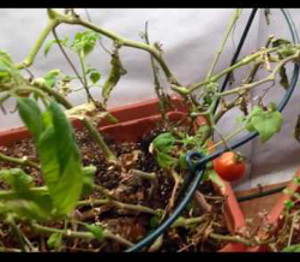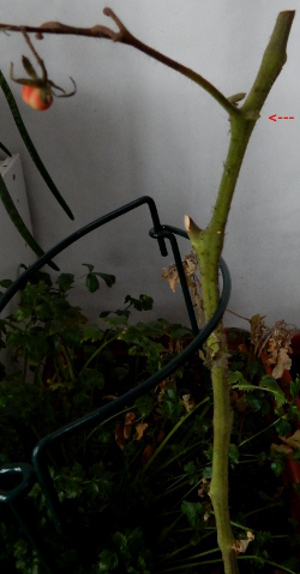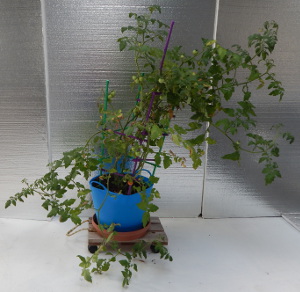
9/16/2017 ~ I brought in the tomato that wilted in the sun, above. I had moved it to the shadiest part of my deck and it ripen only one single tomato all summer. But, perhaps in the bright light of my plant room it will become an over-wintering champion. We’ll see.
As an aside this is the first picture of my newly painted floor. It’s very very white, even when it shows the marks from my rolling walker wheels.
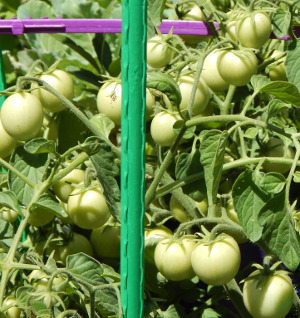
8/12/2017 ~ Of all my tomatoes, the Cherry Falls, above, growing in a Lowe’s 5 gallon bucket, has produced the most lavish crop of tomatoes. And, it’s pretty bushy which will make it great for overwintering, if the light and heat in my plant room are sufficient for it.
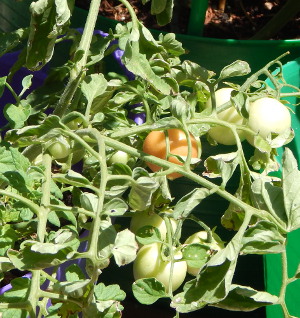
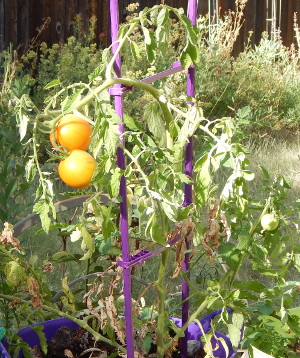
The Amish Gold is slow growing. Today is 9/16 and I’m having my first taste for dinner. It may over-winter only because it’s not intent on being a huge plant. We’ll see.
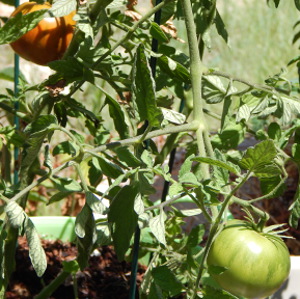
The Paul Robeson is the largest tomato I planted. I mainly chose smaller tomatoes on the theory that they would ripen sooner. I’m really eager to taste this tomato, which had good taste reviews. Mine are about the size of a baseball.
7/31/2017 ~ In order to find a tomato that wants to live over the winter, even producing tomatoes indoors, then jump into ramped up tomato production come spring and a return to the out of doors, I planted 7 different varieties last spring, each of which was said to do well in containers.
Last winter a few tomato plants looked promising, but just when I was counting my several-seasons-early tomatoes, they crashed. One obvious problem was that the vines were outdistancing the LED light. So, when the Heirloom Red Cherry, above, kept wilting in the midday sunshine, I began to have hopes of winter tomatoes in my not so bright living room.
The only problem was that so far the daily wilting had kept the tomato from setting fruit. It might indeed overwinter like a trooper, but if it didn’t produce tomatoes there would be little reason to celebrate.
I moved the ever wilting tomato to the shadiest part of my deck and waited. Clouds and rain ensued. In fact, there hasn’t been a fully sunny day since this chapter of Overwintering Tomatoes. And, the tomato continues to look happy. We’ll see how many tomatoes it produces.
12/27/2016 ~ So far it’s looking hopeful that I will have a tomato plant from last summer to take outside this spring. I’m thinking Early Tomatoes.
Video ~~~> Over Wintering Tomatoes
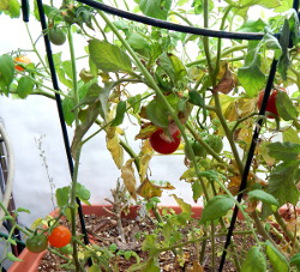 11/14/2016 ~ Maybe it’s too early to be as hopeful as I am this year about over-wintering tomatoes. I was giving up the project, but I have a hard time doing that. Some new thing always pops into mind, making me want to try it. (Which was not the case while my vitamin B12 levels were low.)
11/14/2016 ~ Maybe it’s too early to be as hopeful as I am this year about over-wintering tomatoes. I was giving up the project, but I have a hard time doing that. Some new thing always pops into mind, making me want to try it. (Which was not the case while my vitamin B12 levels were low.)
This fall I began to wonder if I should bring my tomatoes in while it was still relatively warm. I wondered if leaving them out till it was nearly freezing at night, was stressing them too much.
So far this seems to be working quite well. I don’t have as many tomatoes per week as I had in 90* summer, but I’m getting a couple handfuls… and it’s fun. Sadly, the five red tomatoes don’t show very well in the picture. As an aside, did you know that men with red/green color blindness, which is only experienced by men, see red as a sort of grey?
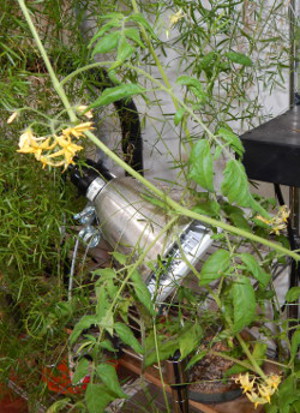
The most promising thing is the number of tomato flower clusters that are appearing. There are three clusters that are easy to see in the picture, and another mid top that is newer and not so easy to see.
I had to shut off the T5 and LED lights to get a good picture, but ordinarily the lights are on several hours a day on sunny days.
I have a narrow clerestory that lets in some sunlight, and I have Solatube, which lets in a lot of light, but not the right wavelengths for tomato growth.
Last year when I brought the tomatoes in only after it was much colder outside they didn’t seem to appreciate the artificial light nearly as much. I brought these tomatoes in a month or more ago.
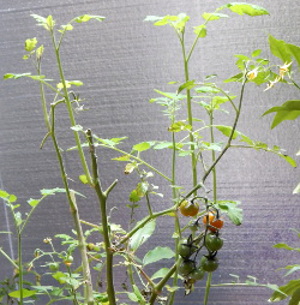
11/30/2015 ~It turns out that your choice of indeterminate tomato makes a lot of difference. Last summer I tried several varieties. Some are “hanging on.” Maybe they’ll survive till they can Spring into production. But, I don’t know. Day by day they are dying back.
That’s not true for one of the cherry tomatoes, however. I’m getting 5 or 6 tomatoes a week as it continues to flower and grow tomatoes.
What has amazed me, and why I’m updating, is that last week I had a fellow come in to help me with the silver-side out insulation in my new plant room. Plus, I couldn’t reach to put a support around the tomatoes which are stretching toward the new skylight, so I asked Mark to help. Sadly, two of the tomato stems broke, “Oh dear, we’ve broken them,” I said.
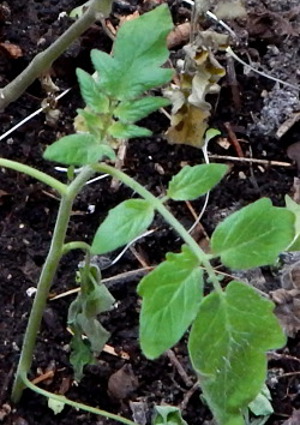 Mark picked up one, stuck it into the soil and said, “There.” I took it to be a nice but rather empty gesture to smooth over the fact we hadn’t been quite careful enough.
Mark picked up one, stuck it into the soil and said, “There.” I took it to be a nice but rather empty gesture to smooth over the fact we hadn’t been quite careful enough.
The tomato top, however, had a completely different view and is happily growing. See photo at left.
Once I saw that Mark’s tomato top hadn’t died, I decided to try it with the tomato stem I’d “laid to rest” on top of the soil. It was laying there for a couple days, so I don’t know if it will be able to grow roots. If it does, I’ll take its picture and add it here.
**********
I wanted to over-winter my tomatoes after the pepper plant I had inside for the winter was super productive come warm weather and a return to my deck. I thought tomatoes would be relatively similar. But, it wasn’t that easy.
Over-wintering Chili and other Peppers ~ Read more.
Requirements for Over-Wintering Tomatoes
Six things impact the success of wintering tomatoes. First, the plant needs to be indeterminate. That is, it just keeps growing. Determinate tomatoes, on the other hand, are genetically structured to stop producing new leaves and tomatoes at some point. They cannot be induced to continue.
The second and third requirements are obvious: heat and light.
I mistakenly thought that heat was covered by the simple fact I brought my tomatoes in, away from freezing temperatures. While I labored under this misconception I focused entirely on light. I got Solatube, believing that would solve the lack of light in my living room where my tomatoes and other plants live for the winter.
The Solatube is Great for bringing in light, but it filters out the wave length used by a lot of plants, apparently to include many tomatoes. Or, it might be fine if only my living room were warmer.
Solatube and Tomatoes ~ Read more.
If your tomato growing area is 65* or warmer, you’re covered for the heat requirement.
Given that I heat with candles, increasing my living room temperature falls largely upon better insulation: early additions to insulation resulted in higher temperatures. For example, My first year heating with candles saw a few freezing nights, literally. At temperatures below 32* I lost many house plants. When I added Orca Grow Film for additional light and to insulate by having an inch of air space behind the film, I gained over 10*. I was now into the 40s, and loving it.
But the Orca’s reflective properties were damaged by condensation resulting from too great a variation in temperature, one side to the other. Adding 1 inch insulation behind the Orca brought the temperature up, closer to 47* on a somewhat consistent basis, ending condensation damage.
Heating with Candles ~ Read more.
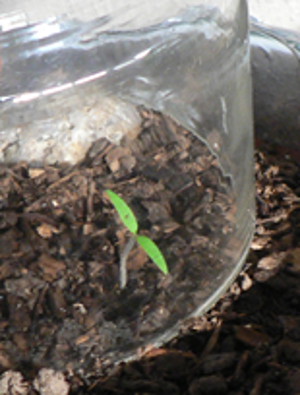
I wondered if tomatoes that thrive in cloudy, rainy England might do better in my living room. The question spurred me to check out Sutton’s Seeds (of England). It turned out that Hundreds and Thousands Tomatoes that do well without much direct sunlight require a minimum of 65*.
I ordered those and Tomato Lizzano seeds from Parks, whose catalog showed them flourishing in the partial shade of an overhang. I planted the seeds in a warm area of my living room, i.e. in a pot on a cart with candle heating on the lower shelf. The seeds germinated, but that was about it. Possibly the soil was relatively warm, but air around the little plants was chilling them into dormancy.
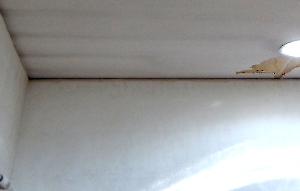
I wondered how much it would help to add 2 inch insulation to the ceiling on its north side where soot indicated a significant temperature difference between the location of the joists and the insulated areas between the joists. You can see the lines on the ceiling, corresponding to the joists. Adding insulation, however, would be tricky because the ceiling is ten feet high. On the other hand, once added it would cover the leak damage after the Solatube was installed. Additionally, it would reduce, if minimally, the volume of my living room and lower the heat that rose to the ceiling by 2 inches.
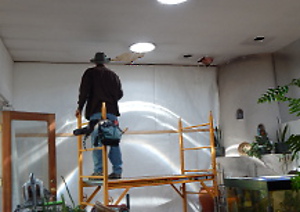
Happily, the man who helped with my batteries said he could do it, using his scaffolding. I knew from his work with the batteries, that he was skilled at measuring… accurately. Not a gift possessed by all helpers, and personally I had no idea how to accurately cut the holes for the Solatube. But, as I say, his measuring skills had been proven, and, I was much in awe.
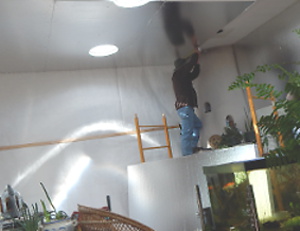
I totally LOVE it. Every time I look at my ceiling, joy sweeps over me. Plus, it seems to have increased the overall light. Best of all, look at how perfect the holes for the Solatube are! What a JOY!
The tinfoil side of the insulation shows. It looks “garden chic”. Years ago when I was a Realtor I used to love the way plaster was left showing, Structolite. Since the look became popular Structolite is sold at a premium.

As I was working on this page a Grandin Road catalog came out showing a striking chest of drawers with a similar look. Which is to say: Put up your garden chic ceiling now ~ be on the leading edge!
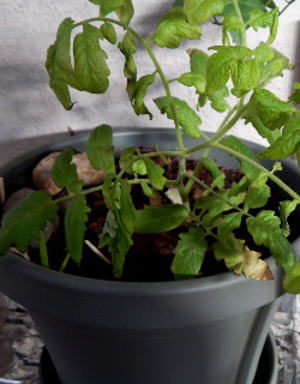
How well did insulating the ceiling work? Almost an additional 10* in warmth. And that was only the first 8 feet of the ceiling. Whereas it was 47* now it’s pretty easily 57*. It goes up to 63* when it’s warm outside and the nights aren’t very cold. Altogether, I wish I’d had 16 feet of the ceiling done. But, looking forward to adding insulation is fun.
This year a tomato in the same location at the Lizzano seedling shown earlier on, did much better. The tomato in question is a volunteer. That’s it on the left.
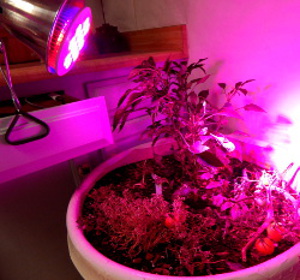

Quest for better light
Taotronic LED plant lamps looked promising and I ordered a few. At 12 watts each, with the electrical genius who reviews on Amazon saying they actually use only 9 watts, to make the bulbs last longer, they were a better choice than my 28 watt T5s.
My tomatoes, avocados, kumquat, collards and peppers liked them. My strawberries did too, except the resulting berries had no flavor. The tomatoes on the other hand, tasted fine.
Then, winter got colder and darker. The night temperature inside was dropping to 55* and snow on my solar panels reduced my ability to have any LED lamps on. At which point my tomatoes nose dived, i.e. their leaves withered. Their stems, however, look healthy and I’m hoping new growth emerges.
4th and 5th over-wintering requirements
The 4th requirement for over-wintering tomatoes is mysterious. I say “mysterious”, because that super strong, large, volunteer tomato plant wilted away in a day, as if a spell had been cast. It had been my most happy-making tomato because it was growing solely in Solatube light, in a fairly warm location. It gave me great hope, until it was felled.
Upon looking more closely there were armadillo bugs in the pot. The tomato’s sturdy stem appeared to be nibbled somewhat severely just below soil level. I had thought the pot to be free of armadillo bugs. So, scratch “mysterious” and replace with “hidden armadillo bugs”, or another predatory (hungry) insect.
The 5th requirement demands study to see which tomato varieties are most keen for additional years of life.
No determinate tomato wants to live more years. Each and every one has been bred to die after producing a number of tomatoes. So, first off, we need to be working with indeterminate tomatoes: ones that will continue to vine and flower… on and on.
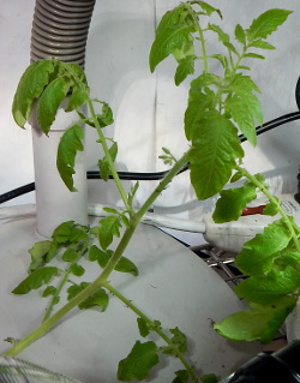
Of my tomatoes, the indeterminate yellow pear looked eager for a second year. Its tiny flower buds suggested new tomatoes all winter. But then the new vine growth shriveled and died.
Its death coincided with a stretch of much colder weather. Instead of the night temperature in my living room being 60* it slipped to 55*. So, that could have been the death blow.

On the other hand, the vine on the far side of the plant was being attacked. The blotches on the stem don’t look like tiny flies, but I think that’s what they were, or their eggs.
When growing outside my tomatoes don’t have pests, or they do but I haven’t seen them. My overall impression of pests is that they flourish when the plant is weakened: too little water, poor soil, perhaps the cold of my living room.
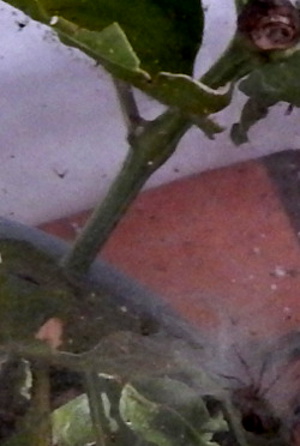
On a nearby pepper plant, there was (and still is) a spider whose web showed the remains of several small flies. Two of the flies are fairly recognizable in the picture.
Pepper plants tolerate a lot more cold than tomato plants. I think the spider may have chosen the pepper plant for its web because the branches and stems don’t have the little hairs that tomatoes have.
Within a few weeks the yellow pear had dry, dead sticks for stems, despite watering.
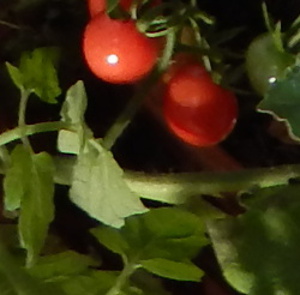
A volunteer cherry tomato that had sprung up in a pot on my deck, which I transplanted to a large pot on its own, flourished for quite a long time. In fact, it’s still holding on, though many branches have wilted and ceased to look happy.
I think it needed more warmth. I’ve now refreshed its soil and hope it sends out new leaves. It was wonderful for setting new flowers and growing more tomatoes, here in the house.
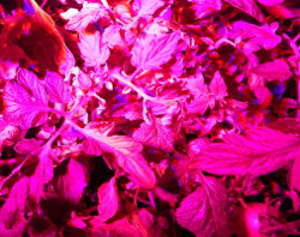
The volunteer tomatoes which seem to be from Solar tomato seed that fell to the ground and got into pots via compost, are the most robust and prolific. They, I thought, would do really well if my living room were closer to 65* than 55*.
So, I moved them to the kitchen, covered the open door with an insulated sheer curtain from Thermalogic, and enjoyed a happy, tomato producing plant for months, till it was cloudy outside and snowing and I couldn’t turn on its LED light.
The LED light is red blue, which is why the picture makes the tomato look more like a magenta coleus.
I’m hoping it revives and sends out some new leaves.
6th and final requirement
If you’re used to not watering plants much during the winter, as I was, then you need to retrain yourself.
Once plants have enough heat and light to grow indoors during the winter, they need quite a lot more water than they did in a colder room.
Here’s Hoping
1/30/2015 ~ The only tomato that appears to be holding onto life is a single upright stem with vestiges of leaves.
The tomato’s stem is so different from that of the pepper that over-wintered last year and was super productive last summer, that I’m questioning whether it’s actually possible to over-winter a tomato.
Maybe its stem would become woody if it were warmer in here. I hope I’m still in my home next winter, so I can see if I can raise the temperature by adding still more insulation.
It would be completely wonderful to have a tomato start out already established and be as productive as my over-wintered pepper was last year.
Foreclosure Awareness ~ Read more.
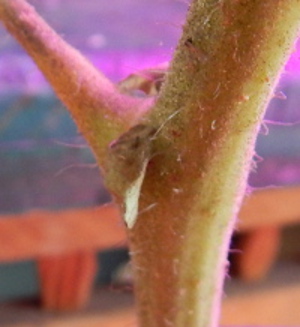
2/19/2015 ~ It looks as if the new leaf on the tomato is a minuscule larger. The tomato stem continues to look healthy. In actual fact the tomato’s stem, stark of leaves, is not all that different from the pepper plant that successfully overwintered last year.
I have another six or seven pots of tomatoes, but you get the general idea.
